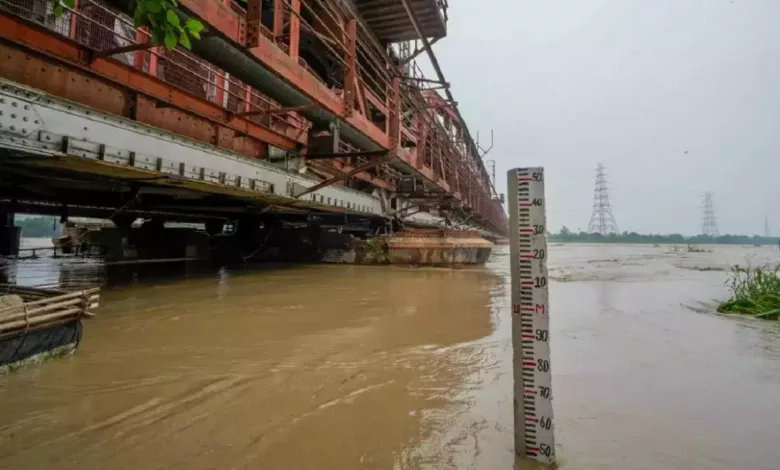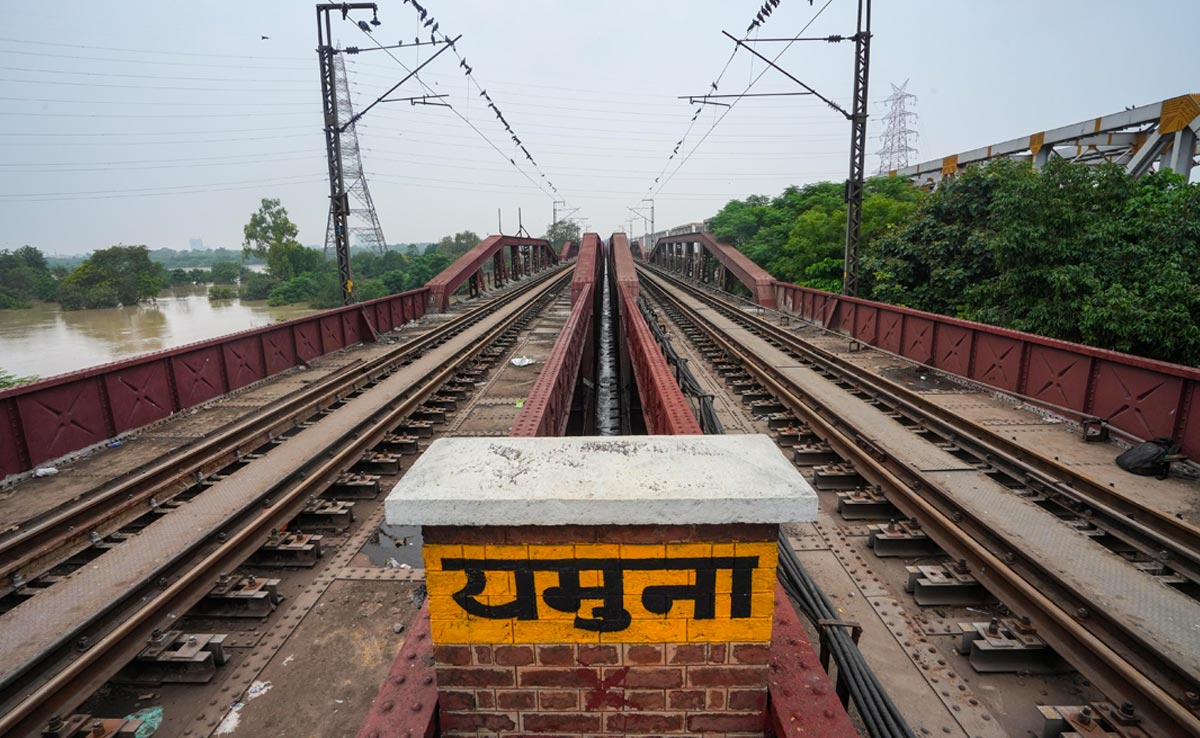Delhi: Yamuna water level drops below danger mark; restrictions to be withdrawn

Delhi: Yamuna water level drops below danger mark; restrictions to be withdrawn
The drop in water level at the Yamuna River in Delhi is a positive development as it indicates that the river is no longer at risk of causing floods or posing a threat to nearby areas. When the water level falls below the danger mark, it means that the river’s flow has reduced and is now within a safe range.
The Yamuna River, which flows through Delhi, is prone to flooding during the monsoon season due to heavy rainfall and the release of excess water from dams upstream. When the water level rises significantly, it can lead to flooding in low-lying areas along the riverbanks, causing damage to properties and disrupting normal life.
Local authorities and disaster management teams closely monitor the water levels in the river during the monsoon season and take necessary precautions to ensure the safety of residents living in vulnerable areas. Early warnings are issued, and evacuation plans may be put into action when the water level approaches or exceeds the danger mark.
)
The drop in water level below the danger mark is a relief for the residents of Delhi and nearby regions, as it indicates that the risk of flooding has reduced. However, it is essential to continue monitoring the river’s water levels and be prepared for any changes in weather patterns that could lead to fluctuations in the river’s flow.
Ensuring proper management of rivers, flood control measures, and sustainable water resource planning are crucial for mitigating the impacts of extreme weather events and safeguarding communities from potential flood risks in the future.
The decrease in the water level at the Old Railway Bridge in Yamuna is a positive development and indicates a further reduction in the river’s flow. The recording of 205.25 meters on July 21 morning is lower than the level recorded on Tuesday evening, which was 205.35 meters.
A declining water level in the river is a sign that the river’s flow is gradually receding and moving towards normal levels. This can help alleviate the risk of floods and potential damages to nearby areas. However, it is important to continue monitoring the water level closely to ensure that it remains within safe limits and does not pose any threat to communities living along the riverbanks.
During the monsoon season, the water level in the Yamuna River can fluctuate significantly due to heavy rainfall and the release of water from upstream reservoirs. As a result, local authorities and disaster management teams need to remain vigilant and take necessary precautions to ensure the safety of residents in vulnerable areas.

The data provided by the Central Water Commission is crucial for understanding the river’s current state and making informed decisions to manage and respond to any potential risks. Effective flood control measures, timely warnings, and community preparedness are essential components of managing water resources and mitigating the impacts of extreme weather events.
The slight rise in the water level of the Yamuna River on Monday, attributed to fresh rainfall in neighbouring Haryana, is a reminder of the river’s susceptibility to fluctuating levels during the monsoon season. The danger mark for the Yamuna River is set at 205.33 meters, and it had breached this mark on July 10, resulting in severe flooding in Delhi.
Given the recent improvements in the waterlogging situation in the city, the Delhi government has taken the decision to lift the ban on the entry of heavy vehicles into the city. This step indicates that the authorities are cautiously monitoring the situation and making adjustments based on the current conditions of the river and its impact on the city.
It is essential for the government and local authorities to remain vigilant and closely monitor weather forecasts, river water levels, and drainage systems to respond effectively to any potential flood threats. The monsoon season can bring unpredictable rainfall and lead to rapid changes in river levels, necessitating timely and coordinated actions to protect communities and infrastructure.
By lifting the ban on heavy vehicles, the government is signaling that the water situation has improved sufficiently to allow normal vehicular movement. However, continued monitoring and preparedness are still critical during the monsoon season to address any potential challenges that may arise due to weather conditions and river fluctuations.The decision to withdraw all restrictions imposed earlier due to the rising water level of the Yamuna River is a positive sign that the flood situation in Delhi has improved. With the water level of the Yamuna River descending below the danger mark, the risk of further flooding in low-lying areas has diminished.
During the period when the river breached the danger mark, several low-lying areas in the city were affected by waterlogging, leading to disruptions and potential risks to residents. In response, the Delhi government swiftly took action to set up relief camps to relocate affected residents and provide them with necessary support and assistance.
As the water level recedes, the risk of flooding and waterlogging in these low-lying areas reduces, allowing the authorities to lift the previously imposed restrictions. This decision demonstrates the effective management and coordination of the government in responding to the flood situation and ensuring the safety and well-being of the residents.
However, it is essential for the authorities to remain vigilant and continue monitoring weather forecasts and river levels to respond proactively in case of any future flood threats. The monsoon season can be unpredictable, and the water levels of rivers can fluctuate, so ongoing preparedness is crucial to address any potential challenges and protect the city from adverse weather conditions.The recent record-breaking water level of the Yamuna River, reaching an all-time high of 208.66 meters, and flowing above the danger mark for eight days, had a severe impact on various parts of Delhi. The heavy rainfall in the upper catchment areas contributed to the swelling of the river, leading to waterlogging and widespread flooding in low-lying areas.
The flooding situation necessitated the evacuation of over 27,000 people from their homes to ensure their safety. The inundation of residential and commercial properties caused significant damage and disruptions to businesses and livelihoods, posing considerable challenges to the affected communities.
During this critical period, the government and various agencies worked diligently to respond to the crisis, providing relief and support to those displaced by the floods. The establishment of relief camps and evacuation centers was crucial in ensuring that affected residents had access to shelter, food, and medical assistance.
As the water level receded below the danger mark, it allowed the authorities to assess the situation and gradually lift the previously imposed restrictions. While the situation has improved, it is essential to remain vigilant, as the monsoon season can bring unpredictable weather patterns that may lead to fluctuations in river levels.
To mitigate the impact of future floods, there is a need to focus on long-term flood management strategies, such as enhancing the city’s drainage systems, implementing flood control measures, and promoting sustainable urban planning to reduce the vulnerability of low-lying areas to flooding.
Addressing climate change and its impact on weather patterns is also critical to prevent extreme rainfall events and their subsequent impact on river levels. It requires a coordinated effort from all stakeholders to build resilience and preparedness to cope with such natural disasters effectively.The recent floods in Delhi have highlighted the importance of addressing human-made factors that contribute to such disasters. Encroachment on the river floodplain, obstruction of the natural flow of the Yamuna, and silt accumulation have all played a role in exacerbating the flooding situation. It is crucial for relevant agencies and authorities to take effective action to make Delhi flood and drought-resistant, prioritizing the common goal over political differences.
Renowned water conservationist Rajendra Singh has emphasized the need for collective efforts to address these issues. This includes implementing measures to restore and maintain the natural flow of the Yamuna, protecting and preserving the river floodplain, and adopting sustainable land-use practices that reduce the risk of flooding.

One of the significant impacts of the recent floods was the disruption of the city’s water supply. The inundation of the pump house at Wazirabad affected the supply of raw water to critical water treatment plants in the area, which are responsible for supplying around 25% of the city’s total water needs. This disruption highlights the vulnerability of the city’s water infrastructure to extreme weather events and the need to strengthen resilience in water supply systems.
To address these challenges, there is a need for comprehensive water management strategies that incorporate flood control measures, watershed management, and sustainable urban planning. It requires close coordination and collaboration among various government agencies, environmental experts, and community stakeholders.
Additionally, investing in modern and resilient infrastructure, such as flood control structures and early warning systems, can help mitigate the impact of extreme weather events and enhance the city’s preparedness to respond to floods.
Beyond immediate flood response, long-term sustainable water management practices, including rainwater harvesting, wastewater treatment, and efficient water usage, are essential to ensure water security for the growing population of Delhi.
Ultimately, addressing the complex challenges posed by floods in Delhi requires a multi-faceted approach that considers both natural and human-made factors, and the collective commitment of all stakeholders to work towards a more resilient and sustainable future.




